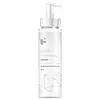What's inside
What's inside
 Key Ingredients
Key Ingredients

 Benefits
Benefits

 Concerns
Concerns

 Ingredients Side-by-side
Ingredients Side-by-side

Water
Skin ConditioningCocamidopropyl Betaine
CleansingGlycerin
HumectantDecyl Glucoside
CleansingPotassium Cocoyl Hydrolyzed Oat Protein
Skin ConditioningPEG-120 Methyl Glucose Dioleate
EmulsifyingButylene Glycol
HumectantRosa Damascena Flower Water
MaskingAllantoin
Skin ConditioningCucumis Sativus Fruit Extract
EmollientRose Flower Oil
MaskingGlycine Soja Seed Extract
Skin ConditioningHelianthus Annuus Seed Oil
EmollientTocopheryl Acetate
AntioxidantSodium Hyaluronate
HumectantPhenoxyethanol
PreservativePPG-13-Decyltetradeceth-24
EmulsifyingPotassium Chloride
Polysorbate 20
EmulsifyingDisodium EDTA
Citric Acid
BufferingPentylene Glycol
Skin Conditioning1,2-Hexanediol
Skin ConditioningBeeswax
Emulsion StabilisingEthylhexylglycerin
Skin ConditioningOlea Europaea Leaf Extract
PerfumingGlyceryl Laurate
EmollientGlyceryl Caprylate
EmollientWater, Cocamidopropyl Betaine, Glycerin, Decyl Glucoside, Potassium Cocoyl Hydrolyzed Oat Protein, PEG-120 Methyl Glucose Dioleate, Butylene Glycol, Rosa Damascena Flower Water, Allantoin, Cucumis Sativus Fruit Extract, Rose Flower Oil, Glycine Soja Seed Extract, Helianthus Annuus Seed Oil, Tocopheryl Acetate, Sodium Hyaluronate, Phenoxyethanol, PPG-13-Decyltetradeceth-24, Potassium Chloride, Polysorbate 20, Disodium EDTA, Citric Acid, Pentylene Glycol, 1,2-Hexanediol, Beeswax, Ethylhexylglycerin, Olea Europaea Leaf Extract, Glyceryl Laurate, Glyceryl Caprylate
Water
Skin ConditioningSodium Laureth Sulfate
CleansingButylene Glycol
HumectantLauryl Glucoside
CleansingCocamide DEA
EmulsifyingCoco-Betaine
CleansingAminomethyl Propanol
BufferingGlycolic Acid
BufferingPhenoxyethanol
PreservativeCitric Acid
BufferingSodium Chloride
MaskingPotassium Sorbate
PreservativePanthenol
Skin ConditioningSodium Cocoyl Glycinate
CleansingAllantoin
Skin ConditioningSodium Benzoate
MaskingEthylhexylglycerin
Skin ConditioningHexamidine Diisethionate
Emollient2-Aminobutanol
BufferingWater, Sodium Laureth Sulfate, Butylene Glycol, Lauryl Glucoside, Cocamide DEA, Coco-Betaine, Aminomethyl Propanol, Glycolic Acid, Phenoxyethanol, Citric Acid, Sodium Chloride, Potassium Sorbate, Panthenol, Sodium Cocoyl Glycinate, Allantoin, Sodium Benzoate, Ethylhexylglycerin, Hexamidine Diisethionate, 2-Aminobutanol
 Reviews
Reviews

Ingredients Explained
These ingredients are found in both products.
Ingredients higher up in an ingredient list are typically present in a larger amount.
Allantoin is a soothing ingredient known for its protective and moisturizingg properties. Because of this, it is often added to products with strong active ingredients.
Studies show higher concentrations of this ingredient can promote wound healing.
Though it can be derived from the comfrey plant, allantoin is produced synthetically for cosmetic products to ensure purity.
Learn more about AllantoinButylene Glycol (or BG) is used within cosmetic products for a few different reasons:
Overall, Butylene Glycol is a safe and well-rounded ingredient that works well with other ingredients.
Though this ingredient works well with most skin types, some people with sensitive skin may experience a reaction such as allergic rashes, closed comedones, or itchiness.
Learn more about Butylene GlycolCitric Acid is an alpha hydroxy acid (AHA) naturally found in citrus fruits like oranges, lemons, and limes.
Like other AHAs, citric acid can exfoliate skin by breaking down the bonds that hold dead skin cells together. This helps reveal smoother and brighter skin underneath.
However, this exfoliating effect only happens at high concentrations (20%) which can be hard to find in cosmetic products.
Due to this, citric acid is usually included in small amounts as a pH adjuster. This helps keep products slightly more acidic and compatible with skin's natural pH.
In skincare formulas, citric acid can:
While it can provide some skin benefits, research shows lactic acid and glycolic acid are generally more effective and less irritating exfoliants.
Most citric acid used in skincare today is made by fermenting sugars (usually from molasses). This synthetic version is identical to the natural citrus form but easier to stabilize and use in formulations.
Read more about some other popular AHA's here:
Learn more about Citric AcidEthylhexylglycerin (we can't pronounce this either) is commonly used as a preservative and skin softener. It is derived from glyceryl.
You might see Ethylhexylglycerin often paired with other preservatives such as phenoxyethanol. Ethylhexylglycerin has been found to increase the effectiveness of these other preservatives.
Phenoxyethanol is a preservative that has germicide, antimicrobial, and aromatic properties. Studies show that phenoxyethanol can prevent microbial growth. By itself, it has a scent that is similar to that of a rose.
It's often used in formulations along with Caprylyl Glycol to preserve the shelf life of products.
Water. It's the most common cosmetic ingredient of all. You'll usually see it at the top of ingredient lists, meaning that it makes up the largest part of the product.
So why is it so popular? Water most often acts as a solvent - this means that it helps dissolve other ingredients into the formulation.
You'll also recognize water as that liquid we all need to stay alive. If you see this, drink a glass of water. Stay hydrated!
Learn more about Water